Top 10 top-dwelling fish to fill top one-third of your aquarium
- Aug 29, 2020
- Anshika Mishra
- 23235 0 0

Today we will be knowing about the top 10 fish that would stay at the top of your tank. Getting a top dwelling fish is hard to find if you know what are you looking for but, you don't know what to ask for at the store.
But if you are a freshwater fishkeeping enthusiast, then here is the list of top 10 top-dwelling fish for your tank.
Brown-tail Pencil fish (Nnnostomus eques)
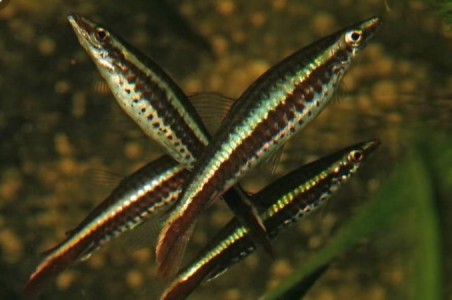
If you want a top-dwelling fish that is cheap and easy then Brown tail Pencilfish is for you. It hangs out at the top, at a 45-degree angle, got a mouth up there looking at the top for little bugs to eat for flake food that you will be dropping in.
SCHOOLING-FISH: Get them in a group of 6 or more; more the married. It looks super cool, but they are not super active. Feed them with little food.
pH: 7 and above, maybe 6.8 but don't go too far down nor too far high.
TAKMATES: This is a community tank fish, from the Amazon, and you can mix it with other similar fish because they are so docile, don't mix it with something's that would beat on them. Don't put them with giant fish.
WATER FLOW: You also don't want crazy high flow at the to either, because they just want to sit up there and drift along with neat little bugs.
PRICE: They cost somewhere between $2-$3. So, pretty cheap to get a school of them.
GREAT FISH! They really add that upper-third of your aquarium. And when you have a big group of people kind of notice, Oh! they are doing what they are supposed to be doing with one. They are great fish and cheap to boot. So, ask your store for them.
Silver Hatchetfish (Gasteropelecus sternicla)
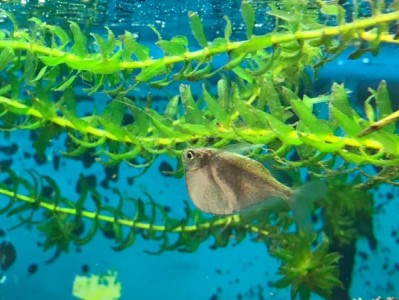
LOOKS: Most of the stores probably have it. They look like Hatchet of the hammer, Right? They have got that body with that big stomach this is of wedge shape.
DIET: They always surf around the top looking for food. They want to eat flake food, they like eating floating food, they want anything that is going to land on the top. They can even jump out for little bugs too.
BIG TIME JUMPER: They are a huge jumper. So make sure, you have got a tight-fitting lid, even back around the filter. They are going to sail right out of there the next time a fruit fly, flies by, it's going for a ride.
pH: 6.8-7.5 is there comfort zone.
TEMPERATURE: The normal tropical temperature, 78, 78, 80 somewhere near there.
QUARANTINE: They can be a little bit finicky when you first get them. So, it is recommended to quarantine them. If they are not getting fed very well to store, thee having to compete with a lot of others. Sometimes they can be a little malnourished and they are likely to get it, especially when you bring them home. So, a quarantine tank recommended.
SCHOOLING FISH: Get them in a group of 6 or more. if you get a big group, and when they all school around, they move at once, if you have actually strong light, it makes like a flash in the room.
SUPER COOL/ SUPER ANNOYING: You will have a good time with these fishes. They can be super cool or super annoying. If you have them in your bedroom super annoying. But it gives a very cool visual display, in the right setting.
Golden Wonder Killifish (Aplochelius lineatus)
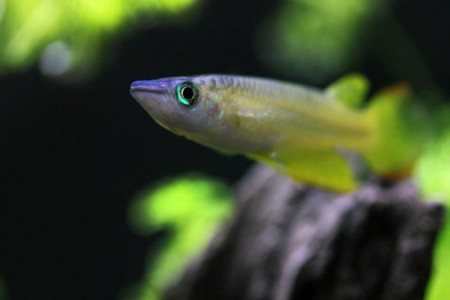 DIET: This is the Killifish that does not get very big, it's got a big mouth on it. So, it can eat bigger things like small fish, blood worms, brine shrimps, other this kind of shrimp. With the big mouth it moves towards the surface, it likes to skim across there looking for things of eating like bugs, if a bug falls in it can eat it.
DIET: This is the Killifish that does not get very big, it's got a big mouth on it. So, it can eat bigger things like small fish, blood worms, brine shrimps, other this kind of shrimp. With the big mouth it moves towards the surface, it likes to skim across there looking for things of eating like bugs, if a bug falls in it can eat it.
PRICE: You can get it for really cheap like $4-$5.
BIG TIME JUMPER: Being a Killifish, known jumper, tight-fitting lids, even background that filter, like absolutely tight. If you even leave a hole a Killifish coup jump out of it, only a matter of time. So really get all sealed before you get them home.
HARDY: They tend to be super-duper hardy, super-duper adaptive like pH form 6.6-8.6 It is the widest range.
TEMPERATURE: They can tolerate 80-82, but really they want to be more like 76-78. So, you would like to run on the lower end of the spectrum, because of the other fish are running. By keeping it down you will get longer longevity out them as well.
MALE FEMALE RATIO: Males have all the color, females not so much, they can be a little aggressive. You don't want like 4 males and 1 female. You want to get some cover-up top, so the can weave in and out of them.
But you will really enjoy this fish, it looks good. Just don't put them with tiny fish, feed them some big meaty food and don't crank the heat up too much
African Butterfly Fish (Pantodon Buchholzi)
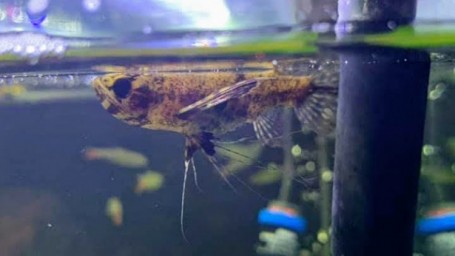
LOOKS: This one is a crazy-looking fish. It actually looks like miniature Arowana that stays at the top of your tank.
TANKMATES: They have big old trapdoor mouth like in Arowana, so you cannot put them with small fish, you have to put them with other mid-size fish might be like Kong Tetra and that type of larger Tetra.
TANK SIZE: Usually in an aquarium that is 30-gallons or more, more the marrier. You can keep them in a group or you can keep them solo. This is one of the nice things about this top-dweller.
DIET: They do want things that float on the top. You can try flake food, you can try pallet, you can try freeze-dried krill, they pretty much eat all of that stuff, given a little time.
COVERUP: Give them a little bit of coverup, maybe a leaf or a floating plant, they just want to sit there, watch stuff going from its mouth, and jump.
pH: it is somewhere from 6.6-7.6 or so.
TEMPERATURE: Normal tropical range, you are keeping a tropical fish in there. Anywhere from 76-82, not too fussy.
MAKE SURE: Other than that make sure that they don't get out-competed for food. If you have got a bunch of those Kongo Tetras and they all are eating all the food at the top then that's a problem. This is the reason why sometimes the floating plant helps, food can hide in the floating plant that the African butterflyfish can eat.
Furcata Rainbowfish (Pseudomugil Furcatus)
CHEERLEADERS: These things are like a little pom-pom, cheerleaders in your tank. They stay in the top third, they move very quickly. They have got blue eyes and these yellowfins that are always just dancing.
SCHOOLING FISH: They are a great fish that should be in a group or in pairs, you can breed them, but it is recommended to have a group of them for like 6 fishes in a tank.
PRICE: You can get them at about $12.
DIET: They will eat anything flake food, frozen food, little pallets, doesn't matter. They are not picky at all.
pH: You can keep them for about 6.8 or above or 7 and above. They do like harder water. But they tolerate such a wide range.
TEMPERATURE: you can keep it at about 72, the hotter you keep them the faster they are gonna burn out. It officially lives about 3-years, you keep them low they will live more if you keep them hot maybe then it will only get in 18 months or 2-years.
TANKMATES: Because they are so fast and can eat, you should not mix it with something like Guppy. They are going to dominate the food, they can torment the guppies if they want to, they are gonna eat frays. Instead, you want to keep it with some other fast fishes like Rasboras or Danios or Tetras and that kind of planted community setup.
WIN-WIN: It's a great fish and yellow is a hard color to come by in your aquarium. So, get top third and yellow, that's a win-win.
Betta (Betta Splendens)
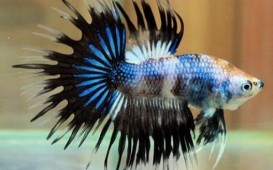
DECORATION: Bettas will go all around the aquarium, when set up correctly, to be on top one-third of the water. So, if you get yourself like a floating Betta cave or, one of those leaves that have suction cups at the sides or a bunch of floating plants or a big leaf up that just sits and watches over the surface of the water. That is where that want to be.
So, you get a fish that will hangout up thereby setting up the environment. Get them a perch or something to hang out in up top and they are gonna thrive.
pH: 6.8-7.8, not to hard water.
TEMPERATURE: 82 is where they do best.
DIET: Meaty food, frozen bloodworms, freeze-dried stuff, pallets all of that will work.
COMMUNITY FISH: Not every Betta can live with every fish, some have a really bad temperament some don't, you are going to have a bit of trial and error there. But in general, they are top-dwelling and can work out great in your community aquarium.
Common Danio
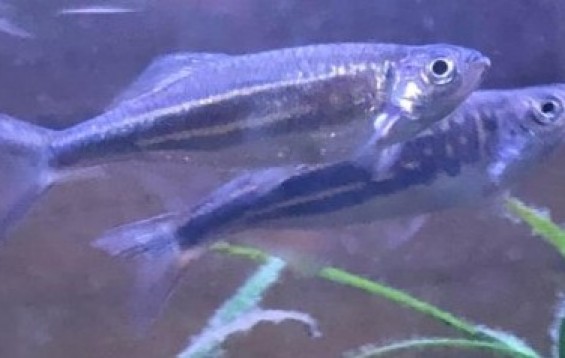
Here we are talking about some of the command Danios like the zebra Danios, leopard Danios, longfin danios all those cheaper. They are the cheaper Danios. They are a great kind of cooler water fish.
TEMPERATURE: They can tolerate 78, but really they want it to be like 72-78, somewhere in there.
SCHOOLING FISH: They are very tight schooling fish, keep them in a group of 6. They will chase each other.
SUPER ACTIVE: No one ever said that Danios are not active enough, its the opposite. They are super active. They will eat almost everything so if you have an inactive aquarium that needs a little bit of spice up the top. The danios are the fish for you.
pH: Anything almost, like 6.8-8, they can thrive in such a wide range there.
GREAT FISH: Food is super wide too, so really easy fish and cheap, they are often overlooked.
Clown Killifish (Epiplatys annulatus)
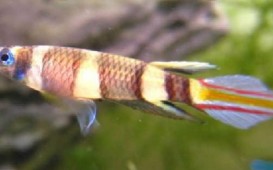
LITTEL ROCKETS: Another Killifish on the list. It is a nano-fish, does not get too big it looks like a rocket.
TIGHT LID: Stays up at the top. without a very tight-fitting lid, they will rocket right out of the aquarium. Ig they can find even a little hole they will jump out. They will be on the ground faster than you know it. One night and they will all be on the ground. So, make sure it's a tight-fitting lid.
PRICE: You can get them for about $5.
DIET: You want to feed them small food like nano-pallets, flake food, frozen baby brine any of that kind of stuff.
pH: anywhere between 6.8-7.8 is a decent range.
TEMPERATURE: If you keep them cooler they will live longer, they would find it easier to breed and that temperature is 74-76. They will go up higher but just know that the metabolism races and time is a tick. And this the only the fish that only last 3-years it so.
GORGEOUS FISH: They have got very little time to breed, a lot of floating plants can facilitate some of the breeding, but if you are mixing them in a community tank, most of their eggs will get eaten by other fish Get a group of 6 or 8 of them. They have got those nice blue eyes, they are always a gorgeous looking fish.
Orange Hatchet Danio (Chela dadiburjori)
It haves a body that is something like a hatchet, it comes out a little bit, it is orange in color with a few stapes on it. This fish will hang out at the top; it is also speedy.
PRICE: they are also more in the $350-$450 per fish range. They are expensive.
Groups of 6 or more definitely recommended.
pH: 6.8-7.8
TEMPERATURE: Cooler again, as mentioned earlier.
EYE-PLEASING FISH: They will eat a wide variety of food, they have just got that orange color which is really pretty, It is more of an eye-pleasing fish, you might have done with all the Dannios and you want to try something different, it will fill that role for you. And they are kind of fun to hunt for because they are not too common.
Halfbeeks
VARIETY: In the market, there are Celebes Halfbeeks, there are Golden Halfbeeks, there are silver Halfbeeks, there is the forest Halfbesks, there is a huge variety in these fish.
LIVE BEARERS: They are a livebearer, they hang out at the top, they will eat there own frays, they will eat smaller fish, they are a little bit predatory fish.
PRICE: they are super fun and you can find them from anywhere from $3 to $20 each depending upon the type you want.
WATER: Most of them are freshwater, but there is some brackish water does that gets sold as freshwater, like the forest Halfbeak. STick yourself to the Celebes or the Silvers or the Golds.
Little floating foods
pH: 6.8-7.8
COVER-UP: Lots of floating cover, so they don't beat on each other or eat their babies, you want to make more because they are so cute.
QUARANTINE: It is found that they are usually underfed coming from stores, So, it is recommended to quarantine them, they usually have a bacterial infection, antibiotics, because they have beating on each other as they didn't have enough cover at the store.
FEEDING THEM: Just keep feeding them tons of floating food, get their those bellies, a lot of time you will be seeing a concave belly and that is a bad side, you don't want to buy that. You should see them eat before you buy them. Make sure they are still eating.
TIGHT LID: Tight-fitting lid again, they will shoot out as they are top-dwellers. With this fish, you sill be having a livebearer up top which is super cool and rare.





About author